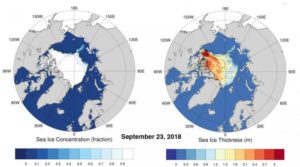by C. Rotter, July 30, 2020 in WUWT

As sea ice in the Arctic retreats further and melts faster every decade, scientists are racing to understand the vulnerabilities of one of the world’s most remote and unforgiving places. A study appearing July 29 in the journal Heliyon details the changes that occurred in the Arctic in September of 2018, a year when nearly 10 million kilometers of sea ice were lost over the course of the summer. Their findings give an overview at different timescales of how sea ice has receded over the 40 years of the satellite era and show how the summer’s extensive decline is linked to global atmospheric processes as far south as the tropics.
At the peak of its melting season, in July 2018, the Arctic was losing sea ice at a rate of 105,500 square kilometers per day–an area bigger than Iceland or the state of Kentucky. “On the ground, I am sure it would have looked like an excellent summer month in the Arctic, in general, but over the past four decades, September sea-ice loss has accelerated to a rate of 12.8% per decade and 82,300 square kilometers per year,” says co-author Avinash Kumar, a senior scientist at the National Centre for Polar and Ocean Research (NCPOR) in India.
…
